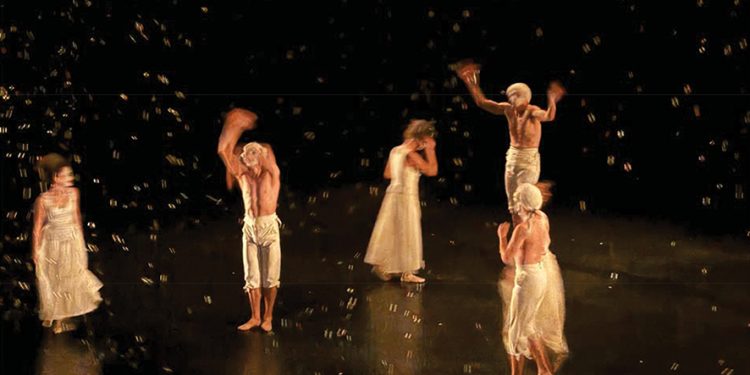The Tbilisi Opera Ballet Theater presented three masterpieces by the legendary Jiri Kylian from October 11-13: Petite Mort (a symphony in miniature), Falling Angels (a ballet in motion), and Sechs Tanze. This celebrated revival was led by Nina Ananiashvili, artistic director, and Levan Jagaev as conductor. It provided a powerful reflection on the intricacies human existence. While each ballet was vastly different, Kylian’s trademark fusion of emotional intensity, discipline, and playful spirit was present in all.
The beauty, power, and proximity of death in Petite Mort
The slow movements of Mozart’s Piano Concerto No. 23 are set to Kylian’s Petite Mort. The delicate intersection between life and death, pleasure and finality is explored in Kylian’s Petite Mort, set to the slow movements of Mozart’s Piano Concerto No. 21 explores the delicate intersection of life and death, enjoyment and finality. David Aladashvili’s live piano performance seemed to evoke the ecstasy of human existence and the fragility of life. This was in line with Kylian’s statement about the fact that the greatest pleasures of life are often tinged by mortality.
The choreography was a dance with subtle tensions, featuring duets that were framed by the poignant metaphor “petite mort.” The fencers’ swords were swung as symbols of masculine strength, but it was their vulnerability that caught the attention. Each torso motion, paired to Mozart’s somber Adagio, felt stripped down of embellishment. It left behind raw, visceral pictures of human bodies grappling their impermanence. The ballet itself, a conversation between life and death, evoked a hypnotic stillness in the audience, as they bore witness to a dance where time stood suspended–contemplating the inevitable.
Falling Angels – The delicate balance of discipline and freedom
Kylian focuses on the complexity of women’s existence within the constraints of art and society in Falling Angels. Steve Reich’s rhythmic Drumming, Part I was performed by eight female dancers who never left the stage. The minimalist score was pulsing, repetitive and accompanied a ballet exploring the tension between discipline, freedom and freedom.
Kylian’s choreography divided the stage into geometrical sections, highlighting the interdependence as well as the individuality of performers. The dancers appeared trapped within these structures but their subtle yearning for freedom was palpable. The work is both a tribute and critique to the pressures put on female performers. It moves seamlessly between moments quiet vulnerability and bursts contained rebellion.
The physicality and intense focus required by Reich’s music was mesmerizing. Each movement was clearly controlled and deeply felt. This was Kylian’s signature blend between emotional expression and formal rigor. The ballet left the audience feeling the constant struggle between belonging and independence, a struggle that is a part of many human experiences, especially for women who navigate the world of performance.
Sechs Tanze – A Dance of Absurdity, Wit and Absurdity
The final work of the evening, Sechs Dance, was a radical departure from the previous works. The playfulness of the piece was a reflection on life’s absurdity, a theme that ran throughout all three pieces. This ballet, set to Mozart’s Six German Dances KV 571 was a whirlwind exuberance and physical comedy.
The dancers wore powdered wigs, 18th century costumes and a sense chaos liberation quickly overtook these formalities. The piece was full of bizarre juxtapositions – from whimsical group moves to sudden moments stillness. The audience laughed at the absurdity, which was contagious. This is a rare reaction for ballet, but it felt in tune with Mozart’s playful score.
Sechs Dance, despite its lighthearted appearance, delved deeper into questions about the nature and purpose of performance. Kylian seemed suggest that beneath the masks, costumes and other adornments, life is a farcical dancing, a fleeting moment, before we face the mysteries beyond. It was an appropriate conclusion to a show that repeatedly returned to themes of life’s brevity and beauty.
Tbilisi Opera Ballet Expands its Creative Expansion
The Tbilisi Opera Ballet’s regular performance of Kylian’s works is more than an artistic challenge. It is an essential step in expanding their repertoire beyond classical ballet. Kylian’s choreography demands that dancers engage with not only technical precision but also deep emotional and intellectual content. His choreography balances minimalism with intense emotion, and this combination of restraint and emotional expression can help dancers to develop a nuanced understanding movement. Working with Kylian’s innovative approach fosters a fresh perspective on physicality and narrative for a group that is traditionally rooted in classics such as Giselle or Swan Lake.
The frequent performance of Kylian’s works also opens the door to the Georgian dance scene being more prominently featured on the international contemporary stage. Kylian’s repertoire is a testament to the artistic depth and versatility of the Tbilisi ballet company, as Georgian Ballet continues to gain international recognition. This constant exposure to contemporary works will lead to a richer and more diverse dance culture, and challenge audiences and performers to engage with ballets in new and profound way.
Ballet as a mirror to the human condition
Jiri Kylian’s works are more than just dances; they are explorations of life’s most essential elements. Kylian uses movement to express love, loss and rebellion. On October 13th, the Tbilisi audience was treated to a night of deeply intellectual but emotionally resonant performances. Each ballet offered a unique reflection on life’s contradictions. The Tbilisi Opera Ballet’s talented musicians and dancers gave Kylian’s timeless themes a new vibrancy. This left the audience with plenty to think about.
This evening of Jiri Kilian’s ballets is a must-see for those who are looking for art that entertains as well as challenges.
Review by Ivan Nechaev
Read More @ georgiatoday.ge













